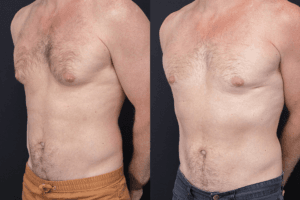The placement of surgical incisions for male breast reduction depends on the type of tissue present and the most suitable surgical technique for the individual.
Liposuction-Only Approach
When excess fatty tissue is present with minimal glandular tissue, small incisions—often less than half an inch—may be made near the edge of the areola or under the arm. A thin tube called a cannula is inserted through these incisions to remove fat.
Combination Approach
If both fatty and glandular tissue are present, incisions may be placed around the areola and/or in the natural crease where the chest meets the abdomen. This approach allows for removal of tissue as required, and in some cases, repositioning of the nipple.
In all cases, the size and location of incisions are planned according to the individual’s needs and the chosen surgical method. The most appropriate approach for your circumstances will be discussed during your consultation.















